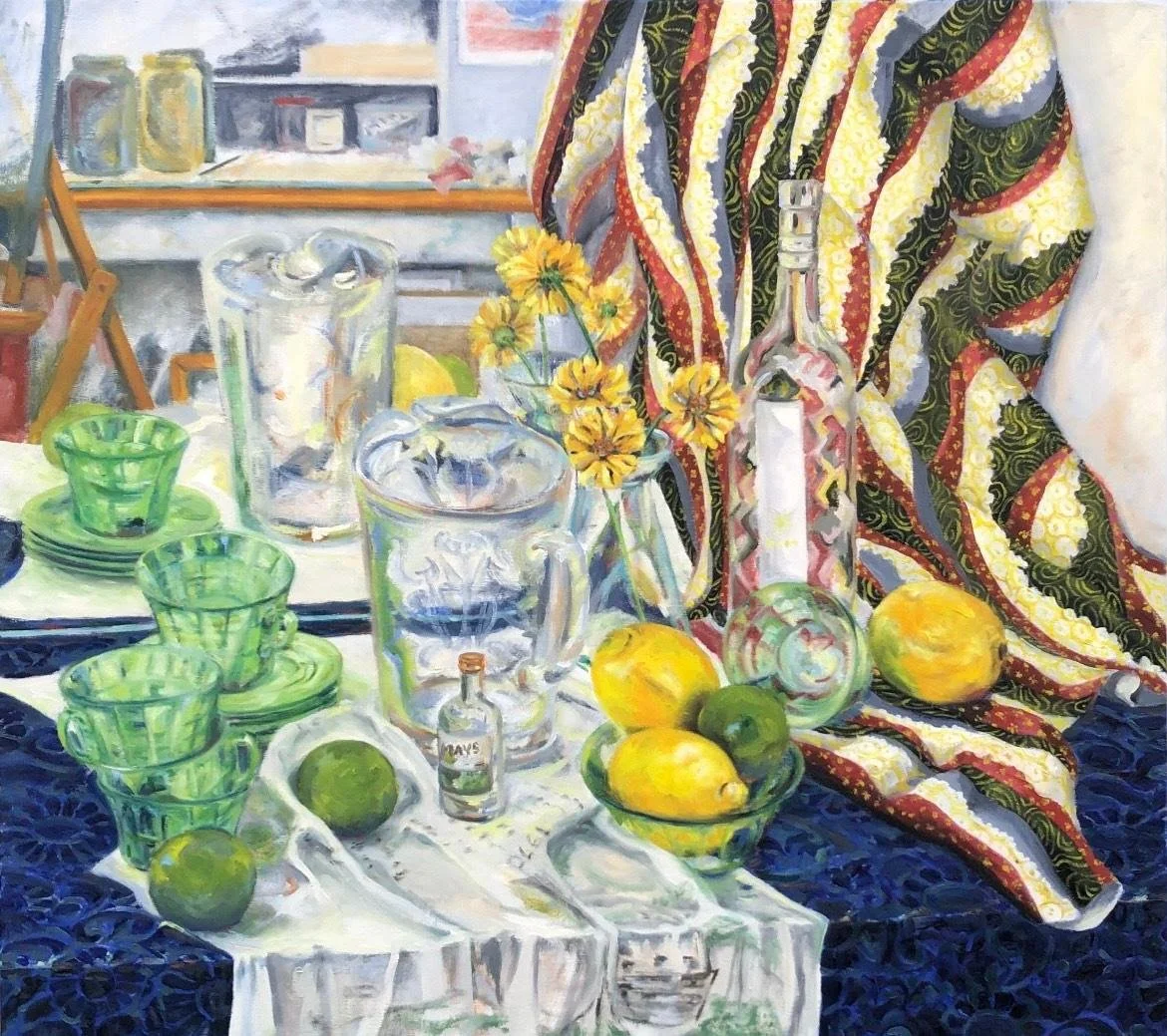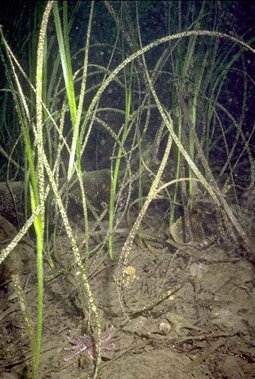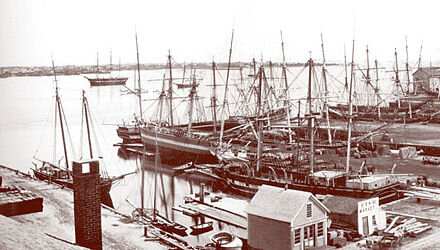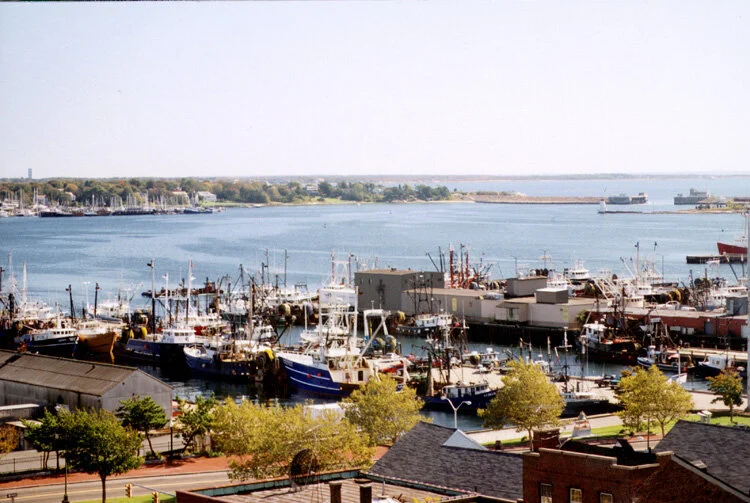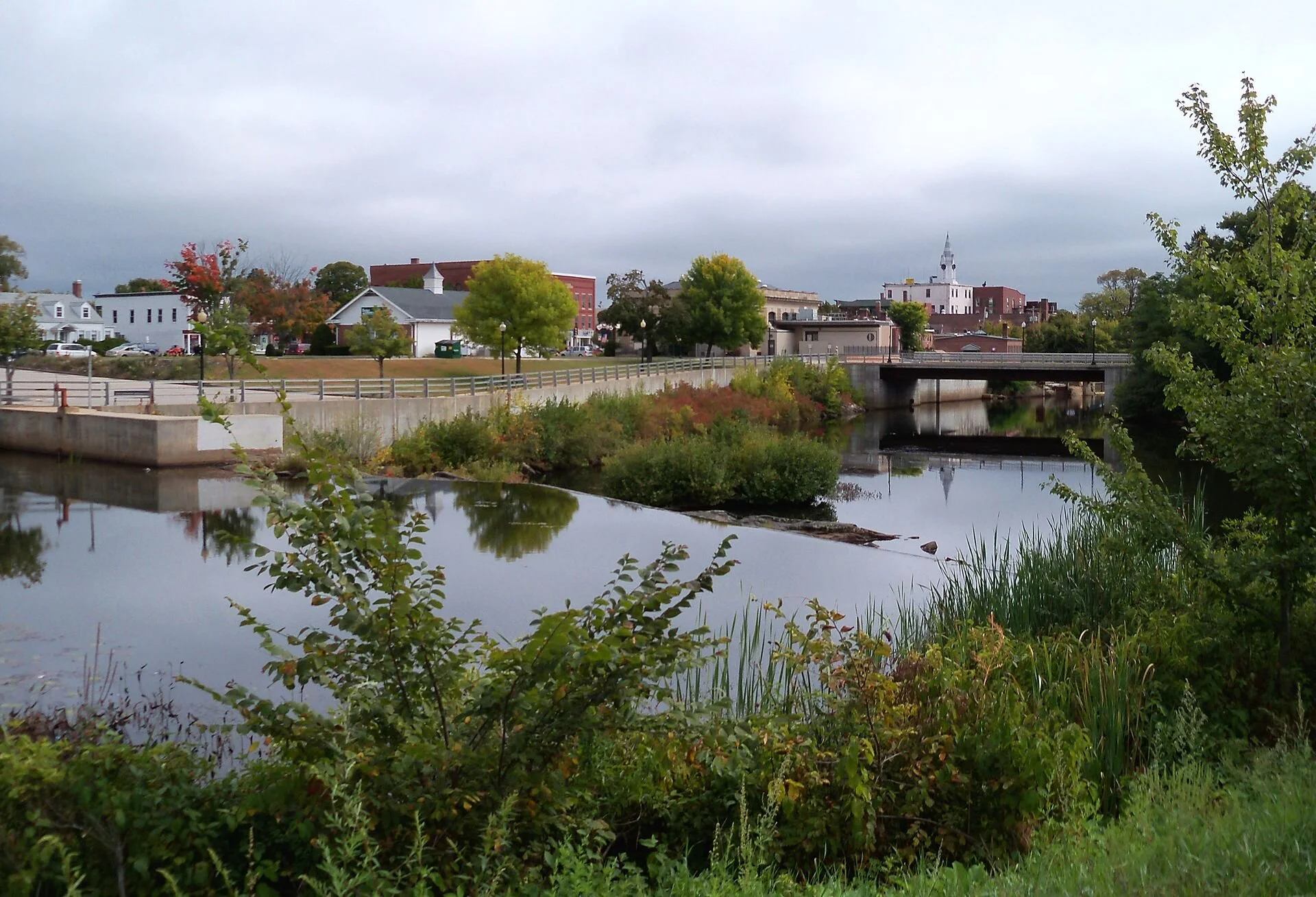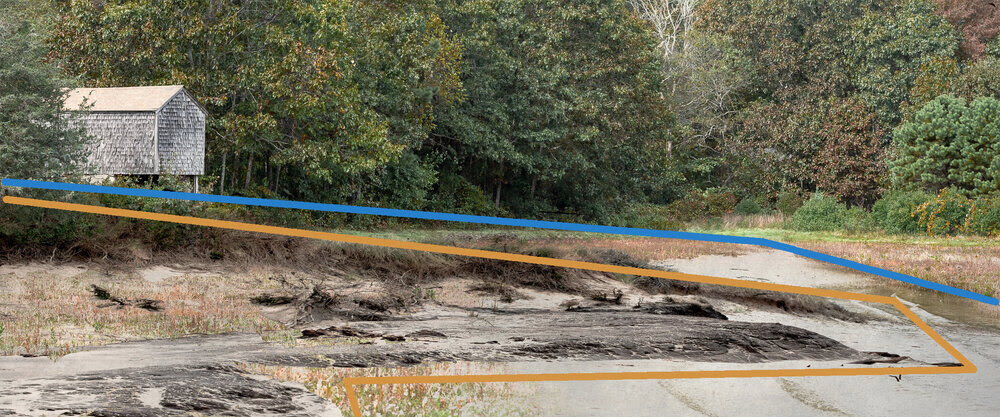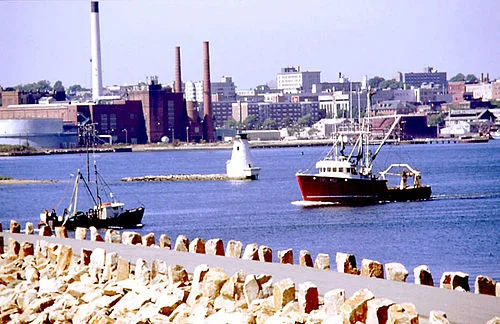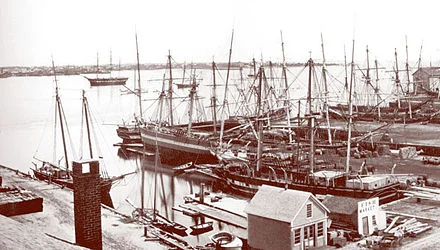
Interacting environments
From “Stems — Paintings by Melinda Lane’’, at Colo Colo Gallery, New Bedford, Mass., through Dec 31.
‘
She says on her Web site:
“Influenced by New England's architecture, and decorative arts I create paintings of interior spaces filled with objects that interest me. I focus on the interaction of decorative materials and nature. The interplay of the natural world and the decorative environment reveals itself as I study the selected objects and the surfaces they occupy. Patterns and rhythms develop as I work to create the structure and space of an interior landscape.
”The process begins with the consideration of objects, surfaces, and vantage points. Common items mix with found objects and plant material as I use color, design, and materials to create an entry point for each painting. These spaces evolve through I study of the objects in situ and develop a geometric scaffold which creates a compositional framework. How do objects interact with each other? How do they sit in space and on the surface? Do color and pattern create movement and rhythm? What shapes and ideas do I discover as I spend time looking? How many layers do I see, and do these layers create an engaging image?
”Over time, sustained observation moves me beyond literal representation, and I create a singular space from a myriad of instances, both observed in the moment and remembered experiences. Rather than present an image, I work to create a space in which the viewer can dwell, explore, and discover their own thoughts and pleasures.’’
Martha Bebinger: In Mass. and elsewhere, what next now that some roadblocks to addiction treatment are gone?
A 2007 assessment of harm from recreational drug use (mean physical harm and mean dependence liability): Buprenorphine was ranked 9th in dependence, 8th in physical harm, and 11th in social harm.
New Bedford in 1876, after the swift decline of the whaling industry as New Bedford became mostly a textile-manufacturing city, like its neighbor Fall River.
BOSTON
For two decades — as opioid overdose deaths rose steadily — the federal government limited access to buprenorphine, a medication that addiction experts consider the gold standard for treating patients with opioid use disorder. Study after study shows it helps people continue addiction treatment while reducing the risk of overdose and death.
Clinicians who wanted to prescribe the medicine had to complete an eight-hour training. They could treat only a limited number of patients and had to keep special records. They were given a Drug Enforcement Administration registration number starting with X, a designation many doctors say made them a target for drug-enforcement audits.
“Just the process associated with taking care of our patients with a substance use disorder made us feel like, ‘Boy, this is dangerous stuff,'” said Dr. Bobby Mukkamala, who chairs an American Medical Association task force addressing substance-use disorder.
“The science doesn’t support that but the rigamarole suggested that.”
That rigamarole is mostly gone. Congress eliminated what became known as the “X-waiver” in legislation President Joe Biden signed late last year. Now begins what some addiction experts are calling a “truth serum moment.”
Were the X-waiver and the burdens that came with it the real reason only about 7% of clinicians in the U.S. were cleared to prescribe buprenorphine? Or were they an excuse that masked hesitation about treating addiction, if not outright disdain for these patients?
There’s great optimism among some leaders in the field that getting rid of the X-waiver will expand access to buprenorphine and reduce overdoses. One study from 2021 shows taking buprenorphine or methadone, another opioid agonist treatment, reduces the mortality risk for people with opioid dependence by 50%. The medication is an opioid that produces much weaker effects than heroin or fentanyl and reduces cravings for those deadlier drugs.
The nation’s drug czar, Dr. Rahul Gupta, said getting rid of the X-waiver would ultimately prevent millions of deaths.
“The impact of this will be felt for years to come,” Gupta said. “It is a true historic change that, frankly, I could only dream of being possible.”
Gupta and others envision obstetricians prescribing buprenorphine to their pregnant patients, infectious disease doctors adding it to their medical toolbox, and lots more patients starting buprenorphine when they come to emergency rooms, primary-care clinics, and rehabilitation facilities.
We are “transforming the way we think to make every moment an opportunity to start this treatment and save someone’s life,” said Dr. Sarah Wakeman, the medical director for substance use disorder at Mass General Brigham, in Boston.
Wakeman said clinicians she has been contacting for the past decade are finally willing to consider treating patients with buprenorphine. Still, she knows stigma and discrimination could undermine efforts to help those who aren’t being served. In 2021, a national survey showed just 22% of people with opioid use disorder received medications such as buprenorphine and methadone.
The test of whether clinicians will step up and if prescribing will become more widespread is underway in hospitals and clinics across the country as patients struggling with addiction queue up for treatment. A woman named Kim, 65, is among them.
Kim’s recent visit to the Greater New Bedford Community Health Center, in southeastern Massachusetts, began in an exam room with Jamie Simmons, a registered nurse who runs the center’s addiction treatment program but doesn’t have prescribing powers. Kaiser Health News agreed to use only Kim’s first name to limit potential discrimination linked to her drug use.
Kim told Simmons that buprenorphine had helped her stay off heroin and avoid an overdose for nearly 20 years. Kim takes a medication called Suboxone, a combination of buprenorphine and naloxone, which comes in the form of thin, filmlike strips she dissolves under her tongue.
“It’s the best thing they could have ever come out with,” Kim said. “I don’t think I ever even had a desire to use heroin since I’ve been taking them.”
Buprenorphine can produce mild euphoria and slow breathing but there’s a ceiling on the effects. Patients like Kim may develop a tolerance and not experience any effects.
“I don’t get high on Suboxones,” Kim said. “They just keep me normal.”
Still, many clinicians have been hesitant to use buprenorphine — known as a partial opioid agonist — to treat an addiction to more deadly forms of the drug.
Kim’s primary-care doctor at the health center never applied for an X-waiver. So for years Kim bounced from one treatment program to another, seeking a prescription. During lapses in her access to buprenorphine, the cravings returned — an especially scary prospect after the powerful opioid fentanyl largely replaced heroin on the streets of Massachusetts, where Kim lives.
“I’ve seen so many people fall out in the last month,” Kim said, using a slang term for overdosing. “That stuff is so strong that within a couple minutes, boom.”
Because fentanyl can kill so quickly, the benefits of taking buprenorphine and other medications to treat opioid-use disorder have increased as deaths linked to even stronger types of fentanyl rise.
Buprenorphine is present in a small percentage of overdose deaths nationwide, 2.6%. Of those, 93% involved a mix of one or more other drugs, often benzodiazepines. Fentanyl is in 94% of overdose deaths in Massachusetts.
“Bottom line is, fentanyl kills people, buprenorphine doesn’t,” Simmons said.
That reality added urgency to Kim’s health center visit because Kim took her last Suboxone before arriving; her latest prescription had run out.
Cravings for heroin could have returned in about a day if she didn’t get more Suboxone. Simmons confirmed the dose and told Kim that her primary care doctor might be willing to renew the prescription now that the X-waiver is not required. But Dr. Than Win had some concerns after reviewing Kim’s most recent urine test. It showed traces of cocaine, fentanyl, marijuana, and Xanax, and Win said she was worried about how the street drugs might interact with buprenorphine.
“I don’t want my patients to die from an overdose,” Win said. “But I’m not comfortable with the fentanyl and a lot of narcotics in the system.”
Kim was adamant that she did not intentionally ingest fentanyl, saying it might have been in the cocaine she said her roommate shares occasionally. Kim said she takes the Xanax to sleep. Her drug use presents complications that many primary care doctors don’t have experience managing. Some clinicians are apprehensive about using an opioid to treat an addiction to opioids, despite compelling evidence that doing so can save patients’ lives.
Win was worried about writing her first prescription for Suboxone. But she agreed to help Kim stay on the medication.
“I wanted to start with someone a little bit easier,” Win said. “It’s hard for me; that’s the reality and truth.”
About half of the providers at the Greater New Bedford health center had an X-waiver when it was still required. Attributing some of the resistance to having the waiver to stigma or misunderstanding about addiction, Simmons urged doctors to treat addiction as they would any other disease.
“You wouldn’t not treat a diabetic; you wouldn’t not treat a patient who is hypertensive,” Simmons said. “People can’t control that they formed an addiction to an opiate, alcohol, or a benzo.”
Searching for Solutions to Soften Stigma
Although the restrictions on buprenorphine prescribing are no longer in place, Mukkamala said the perception created by the X-waiver lingers.
“That legacy of elevating this to a level of scrutiny and caution —that needs to be sort of walked back,” Mukkamala said. “That’s going to come from education.”
Mukkamala sees promise in the next generation of doctors, nurse practitioners, and physician assistants coming out of schools that have added addiction training. The American Medical Association and the American Society of Addiction Medicine have online resources for clinicians who want to learn on their own.
Some of these resources may help fulfill a new training requirement for clinicians who prescribe buprenorphine and other controlled narcotics. It will take effect in June. The DEA has not issued details about the training.
But training alone may not shift behavior, as Rhode Island’s experience shows.
The number of Rhode Island practitioners approved to prescribe buprenorphine increased roughly threefold from 2016 to 2022 after the state said physicians in training should obtain an X-waiver. Still, having the option to prescribe buprenorphine “didn’t open the floodgates” for patients in need of treatment, said Dr. Jody Rich, an addiction specialist who teaches at Brown University. From 2016 to 2022, when the number of qualified prescribers increased, the number of patients taking buprenorphine also increased, but by a much smaller percentage.
“It all comes back to stigma,” Rich said.
He said long-standing resistance among some providers to treating addiction is shifting as younger people enter medicine. But tackling the opioid crisis can’t wait for a generational change, he said. To expand buprenorphine access now, states could use pharmacists, partnered with doctors, to help manage the care of more patients with opioid use disorder, Rich’s research shows.
Wakeman, at Mass General Brigham, said it might be time to hold clinicians who don’t provide addiction care accountable through quality measures tied to payments.
“We’re expected to care for patients with diabetes or to care for patients with heart attack in a certain way and the same should be true for patients with an opioid use disorder,” Wakeman said.
One quality measure to track could be how often prescribers start and continue buprenorphine treatment. Wakeman said it would help also if insurers reimbursed clinics for the cost of staff who aren’t traditional clinicians but are critical in addiction care, like recovery coaches and case managers.
Will Ending the X-Waiver Close Racial Gaps?
Wakeman and others are paying especially close attention to whether eliminating the X-waiver helps narrow racial gaps in buprenorphine treatment. The medication is much more commonly prescribed to white patients with private insurance or who can pay cash. But there are also stark differences by race at some health centers where most patients are on Medicaid and would seem to have equal access to the addiction treatment.
At the New Bedford health center, Black patients represent 15% of all patients but only 6% of those taking buprenorphine. For Hispanics, it is 30% to 23%. Most of the health center patients prescribed buprenorphine, 61%, are white, though white patients make up just 36% of patients overall.
Dr. Helena Hansen, who co-authored a book on race in the opioid epidemic, said access to buprenorphine doesn’t guarantee that patients will benefit from it.
“People are not able to stay on a lifesaving medication unless the immense instability in housing, employment, social supports — the very fabric of their communities — is addressed,” Hansen said. “That’s where we fall incredibly short in the United States.”
Hansen said expanding access to buprenorphine has helped reduce overdose deaths dramatically among all drug users in France, including those with low incomes and immigrants. There, patients with opioid use disorder are seen in their communities and offered a wide range of social services.
“Removing the X-waiver,” Hansen said, “is not in itself going to revolutionize the opioid overdose crisis in our country. We would need to do much more.”
This article is part of a partnership that includes WBUR, NPR and Kaiser Health News.
Martha Bebinger is a journalist with WBUR, in Boston
Cross-species and cross-cultural communication
“Inside the Belly of a Rabbit’’ (watercolor on paper), by New York-based artist Dana Sherwood, in the show “Dana Sherwood: Some Kind of Tea Party or Thereabouts in the Realm of Madness,” at the University of Massachusetts at Dartmouth’s University Art Gallery, in downtown New Bedford, through Dec. 28.
© Dana Sherwood
The gallery says:
“This exhibition, which includes films, ceramics, oil and watercolor paintings, explores the relationship between humans and the natural world, drawing on the artist’s exploration of cross-species communication, domestic culture, and the mythical connections between the feminine and natural world in a changing environment.’’
“Gosnold at the Smoking Rocks” (oil on canvas, 1842), by William Allen Wall, at the New Bedford Whaling Museum. It’s a romanticized depiction of English explorer Bartholomew Gosnold meeting a few of the local Wampanoag people in 1602. Gosnold (1571-1607) was said to be the first European to set foot in what’s now called New Bedford.
‘Designed for EXCESS’
Left, Abelardo Morell’s “Paint #16” (photo). Right: Anthony Fisher’s “The Light of Day” (oil on canvas), in their joint show “Two of a Kind: Abelardo Morell and Anthony Fisher,” at the University of Massachusetts at Dartmouth Art Gallery, at its Star Store Campus, in downtown New Bedford, Feb. 10-March 20.
The gallery says:
“This exhibition presents two creative approaches that focus on the abstract image – Abelardo Morell’s incredibly lush and sensual photographs of fresh paint frozen in time with the help of light, fast exposure and flash, and Anthony Fisher’s ingeniously captured lines and shapes featured on layered, monochromatic abstract paintings.
Both Morell and Fisher share a restless urgency to invent novel ways to play with traditional media, subjects, and methods. In their respective studios in the same creative community just outside of Boston, each pours his unique experimentation into their own patient and carefully crafted process. Results sometimes arrive as wonderful surprises transformed into bold work that the visitor can almost enter – inspiring, open minded, and deeply creative.’ Abelardo Morell admires Anthony’s work because he, ‘like me, thinks a lot about how a picture is made. Subject matter for him is, of course, important, but it is within his working process that the subject emerges. Anthony has used all sorts of devices to make marks on the canvas – perhaps to get his ego out of the way a bit.’
“Anthony Fisher’s studio process involves quirky and lumbering invented tools, physical struggle, gravity, chemistry, and physics to allow hundreds of marks to be thrown onto a canvas all at once. ‘My process is specifically designed for EXCESS – with so many visual ideas emerging at once, the overwhelmingly vast majority are discarded. I want the unexpected. My goal is to spark ideas that otherwise wouldn’t appear with a more deliberative, considered approach,’ says Fisher.’’
Abelardo Morell explains his admiration for the subject matter of his photographs, “When I visit museums, my eyes often take me first to the painting galleries. I marvel at the surfaces of paintings, which contain their own visual dramas, often independent of any narrative or formal aspect of the work. A difference between us as a photographer and painter is that photographers normally start with the world, while painters begin with a blank canvas and end up at times with astonishing creations.” Morell’s photographs show “that substance on its way to drying – a stage that finished paintings can never retain. “I also use other lighting sources pointed at a low angle to increase the raking light effects on the thick paint surface. I like the translucent and geometric visual marriages achieved through this method. Because what I am making are not ‘paintings’ in their own right, I am able to quote and crop discrete small paint details to make them play a big role in the final picture.”
Created specifically for this exhibition and presented at the gallery’s entrance is another visual surprise that underlines the connection between these two artists, neighbors and friends – a photograph of Abelardo Morell titled, “Paint: After Anthony Fisher’s 2021 Painting ‘Some Will Still Be Standing’, 2022” right next to the actual paintin
William Street, New Bedford, in the old “Whaling Capital’s’’ 19th Century section.
— Photo by PenitentWhaler
Todd McLeish: Seeking strategies for sustaining bay scallops
Bay scallop staring at you with its blue eyes
From ecoRI News (ecori.org)
In the Great Salt Pond on Block Island, native bay scallops are thriving like nowhere else in Rhode Island. Scientists from The Nature Conservancy survey the 673-acre tidal harbor every autumn and have recorded hundreds of scallops each year, despite as many as 50 recreational shellfishermen harvesting scallops from the pond each November and December.
The same cannot be said of the rest of the Ocean State’s waters, however, where bay scallops are few and far between.
On Block Island, Diandra Verbeyst leads a three-person team of Nature Conservancy scuba divers and snorkelers who monitor 12 sites around the Great Salt Pond. They have counted an average of 225 scallops annually since 2016, up from just 44 observed by previous observers in 2007, the first year of monitoring.
“There are slight rises and falls from year to year, but the population is pretty stable,” Verbeyst said. “Based on the 12 sites we monitor, the population is indicating that there is spawning happening each year, and there is recruitment to the population.”
In addition to scallop data, Verbeyst and her team also collect information on water quality and other environmental conditions during their surveys.
“The scallops are an indication that the ecosystem is healthy and doing well, and for me, that’s fascinating in itself,” she said. “No matter where you are in the pond, there’s a good chance you’ll see a scallop.”
Bay scallops are bivalve mollusks with 30-40 bright blue eyes that live in shallow bays and estuaries up and down the East Coast, preferring habitats where eelgrass is abundant. They are short-lived animals — most don’t live more than two years — and are significantly smaller than sea scallops, which are found farther offshore and are harvested by the millions by New Bedford-based fishermen.
Chris Littlefield, a Nature Conservancy coastal projects director and former part-time shellfisherman on Block Island, recalled collecting scallops as a child in the Great Salt Pond 50 years ago, and he has been gathering them in small numbers for his family’s consumption ever since. He said the scallop population received a boost in 2010, when immature scallops grown at the Milford {Conn.} Laboratory of the National Oceanic and Atmospheric Administration were dispersed into the pond in a project funded by the Natural Resources Conservation Service.
“That project broke through some kind of threshold,” Littlefield said. “Scallops weren’t as abundant before that, and they used to be confined to certain key locations and that was it. But now they’re more abundant and more people are finding them and harvesting them.”
Unlike Nantucket, Martha’s Vineyard and a few locations on Cape Cod and Long Island, where regular seeding of immature bay scallops has resulted in thriving commercial fisheries, Rhode Island has a tiny commercial fishery for bay scallops — fewer than three fishermen participate — and the fishery is not sustainable.
Anna Gerber-Williams, principal marine biologist for the Rhode Island Department of Environmental Management’s Division of Marine Fisheries, just completed the first year of a three-year effort to assess the state’s bay scallop population. She is focused primarily on the salt ponds in South County, especially Point Judith Pond and Ninigret Pond, which historically had healthy bay scallop populations.
“We manage and regulate the bay scallop harvest, but besides Block Island, we haven’t had an actual assessment of what the population looks like in Rhode Island,” Gerber-Williams said. “We know it’s pretty low, and we know the actual commercial harvest numbers are very low. But we don’t have anything to base our management on. The hope is that this project can turn into more long-term monitoring, similar to what’s done on Block Island, and maybe lead to restoration efforts.”
Based on her first year of surveys, Gerber-Williams said there are self-sustaining populations of bay scallops in Point Judith Pond, and their abundance can fluctuate significantly from year to year.
“Scallops are very habitat-dependent,” she said. “The habitat in the salt ponds is very patchy, and those patches are very small.”
Unlike clams, which bury themselves in the sand, bay scallops sit on the seafloor and can swim around by rapidly opening and closing their shell, making them difficult to track and count. Gerber-Williams said they are threatened by several varieties of crabs, which can easily crush the scallops’ shells with their claws.
“Part of the scallop’s strategy is to hide from the crabs in the eelgrass,” she said. “When they’re younger, they attach themselves to eelgrass blades to keep themselves above the bottom and out of reach of predators.”
Dan Torre at Aquidneck Island Oyster Co. experimented this year with growing bay scallops in cages in the Sakonnet River off Portsmouth. He bought scallop seed from area hatcheries last July, and they are approaching marketable size now. He has contracted with one local restaurant to buy his experimental crop, with hopes of scaling up the operation next year.
“I believe there’s a market, but it’s a niche market,” he said. “Normally with sea scallops, you sell just the shelled adductor muscle, but with bay scallops you sell the whole animal. The shelf life isn’t the longest, but it seems like there are a bunch of restaurants that are eager to try them.”
In an effort to figure out how best to restore wild bay scallop populations in the region, the Rhode Island Commercial Fisheries Research Foundation is collaborating with The Nature Conservancy to synthesize what is known about the history of the bay scallop population and fishery in Point Judith Pond.
According to Dave Bethoney, the foundation’s executive director, it will be combined with information about scallop fisheries in Massachusetts and Long Island, N.Y., as a first step to developing a restoration plan.
“How to make them sustainable is the real puzzle,” Bethoney said. “Even successful efforts on Long Island are based on a seeding plan — getting scallops every year from aquaculture facilities to replenish them. They have successful populations, but they’re not self-sustaining. I don’t know how we change that.”
Gerber-Williams agreed.
“In my opinion, the way to boost populations here and keep them at a level that’s sustainable for a good fishery in Rhode Island, we would have to have a seeding program similar to what they have in Long Island and Martha’s Vineyard,” she said. “Every year they put out thousands of baby bay scallops. They seed their salt ponds every single year to keep a decent fishery going.
“So the next step for us would be to do that kind of seeding program in Rhode Island. We’re in the process of creating a restoration plan for various species of shellfish in Rhode Island, and my hope is that bay scallops are a part of that.”
Hopefully the current researchers go back to the North Cape shellfish injury restoration project, which included release of bay scallop seed into the South County salt ponds, to learn about what worked or did not work for the multi-year that wrapped up by 2010. The reports are available and some of us who worked on the project are available to discuss challenges and successes.
Todd McLeish is an ecoRI News contributor.
Eelgrass is prime habitat for bay scallops.
Beats whale-oil lamps
“One Bulb (Version II)” (12 Gelatin Silver Prints on Ilford Matte), by Amanda Means, at the University of Massachusetts at Dartmouth’s art gallery in New Bedford, Oct., 14-Oct. 23.
New Bedford waterfront in 1867. For part of the 19th Century, New Bedford was the world’s whaling capital.
John O. Harney: N.E.’s changing ethnic demographics; shrinking police forces; honorary degrees and culture wars
1. Northwest Vermont 2. Northeast Kingdom 3. Central Vermont 4. Southern Vermont 5. Great North Woods Region 6. White Mountains 7. Lakes Region 8. Dartmouth/Lake Sunapee Region 9. Seacoast Region 10. Merrimack River Valley 11. Monadnock Region 12. North Woods 13. Maine Highlands 14. Acadia/Down East 15. Mid-Coast/Penobscot Bay 16. South Coast 17. Mountain and Lakes Region 18. Kennebec Valley 19. North Shore 20. Metro Boston 21. South Shore 22. Cape Cod and Islands 23. South Coast 24. Southeastern Massachusetts 25. Blackstone River Valley 26. Metrowest/Greater Boston 27. Central Massachusetts 28. Pioneer Valley 29. The Berkshires 30. South Country 31. East Bay and Newport 32. Quiet Corner 33. Greater Hartford 34. Central Naugatuck Valley 35. Northwest Hills 36. Southeastern Connecticut/Greater New London 37. Western Connecticut 38. Connecticut Shoreline
BOSTON
From The New England Journal of Higher Education (NEJHE), a service of The New England Board of Higher Education (nebhe.org)
Population studies. The U.S. Census Bureau released new population counts to use in “redistricting” congressional and state legislative districts. Delayed by the pandemic, the counts came close to the legal deadlines for redistricting in some states, raising concerns about whether there would be enough time for public input.
The U.S. population grew 7.4% in 2010-2020, the slowest growth since the 1930s, according to the bureau. The national growth of about 23 million people occurred entirely of people who identified as Hispanic, Asian, Black or more than one race.
The Associated Press reported:
The population under age 18 dropped from 74.2 million in 2010 to 73.1 million in 2020.
The Asian population increased by one-third over the decade, to stand at 24 million, while the Hispanic population grew by almost a quarter, to top 62 million.
White people made up their smallest-ever share of the U.S. population, dropping from 63.7% in 2010 to 57.8% in 2020. The number of non-Hispanic white people dropped to 191 million in 2020.
The number of people identifying as “two or more races” soared from 9 million in 2010 to 33.8 million in 2020, accounting for about 10% of the U.S. population.
A few New England snippets
Maine remains the nation’s oldest and whitest state, even though it saw a 64% increase in the number of Blacks from 2010 to 2020, as well as large increases in the number of Asians and Pacific Islanders.
Connecticut’s population crawled up 0.9% over the decade from 2010 to 2020 to 3,605,944 residents. The number of residents who are Black, Indigenous and People of Color (BIPOC) increased from 29% of the population in 2010 to 37% in 2020. Connecticut’s number of congressional seats won’t change, but district borders will.
The total population of the only city on Boston’s South Shore, Quincy, Mass., topped 100,000 (at 101,636), as its Asian population grew to represent nearly 31% of all residents. Further south, the city of Brockton’s population increased by nearly 13% as the white population dropped by 29%, and the Black population increased by 26%.
Amazon jungle. Amazon last week announced it will pay full college tuition for its 750,000 U.S. hourly employees, as well as the cost of earning high school diplomas, GEDs, English as a Second Language (ESL) and other certifications. While collecting praise for its educational goodwill, stories of dire conditions in the e-commerce giant’s workplace also triggered a new California law that would ban all warehouses from imposing penalties for “time off-task” (which reportedly discouraged workers from using the bathroom) and prohibit retaliation against workers who complain.
Police shrink. Police forces in New England have recently felt new recruitment and retention pressures. In August 2021, The Providence Journal ran a piece headlined “Promises made, promises delivered? A look at reforms to New England police departments.” GoLocal reported that month that Providence policing staff levels stood at 403, down from 500 or so in the 1980s under then-Mayor David Cicilline. The number of officers employed by Maine’s city and town police departments and county sheriffs’ offices shrank by nearly 6% between 2015 and 2020, according to the Maine Criminal Justice Academy. Reporter Lia Russell of the Bangor Daily News noted, “It’s also a challenge that police in Maine are far from alone in facing, especially following a year during which police practices across the nation were called into question following the murder of George Floyd by Minneapolis police Officer Derek Chauvin.” The Burlington, Vt., City Council in August defeated efforts to reverse a steep cut in city police ranks. The police department currently has 75 sworn officers, down from 90 in June 2020. A survey by the police officers’ union found that roughly half of Burlington cops were actively seeking employment elsewhere.
Honor roll. Honorary degrees are becoming something of a frontline in the culture wars. Springfield College alumnus Donald Brown, who recently coauthored a piece for NEJHE, tells of his alma mater revoking the honorary master of physical education degree it had bestowed on U.S. Olympic Committee Chair Avery Brundage in 1940. In 1968, Brundage pressured the U.S. to take action against two Olympic athletes who gave the Black Power salute after finishing first and second in the 200 meters. That event was only the tip of the iceberg. Brundage had a history of anti-semitism, sexism and racism. Springfield President Mary-Beth Cooper met with the trustees and others and decided to take back the honor. Meanwhile, the University of Rhode Island has been tying itself in knots over the honorary degree it bestowed on Michael Flynn in 2014, before he was appointed Trump’s national security adviser and accused of sedition.
Refugees. After the U.S. ended its longest war (so far) in Afghanistan and the capital of Kabul fell, the question arose of where Afghan refugees would resettle. New England cities, including Worcester, Providence and New Haven, are among those that have readied plans to welcome Afghan refugees. In higher education, Goddard College President Dan Hocoy said it was a “no-brainer” to offer to house Afghan refugees at its Plainfield, Vt., campus for at least two months this upcoming fall. Back in 2004, NEJHE (then Connection) featured an interview with Roger Williams University President Roy J. Nirschel, who died in 2018, and his former wife Paula Nirschel on the university’s role in its community as well as their pioneering initiative to educate Afghan women.
Sunshine state. Before Florida Gov. Ron DeSantis took his most recent stand against fighting COVID, he displayed a narrow-mindedness that seems to always be in fashion. As Inside Higher Ed reported, after expressing concerns about faculty members “indoctrinating” students, DeSantis signed a law requiring that public institutions survey students, faculty and staff members about their viewpoint diversity and sense of intellectual freedom. The Miami Herald reported that DeSantis and state Sen. Ray Rodrigues, the original bill’s Republican sponsor, suggested that the results could inform budget cuts at some institutions. Faculty members have opposed the bill, which also allows students to record their professors teaching in order to file free speech complaints against them.
New colleges in a time of contraction. The nonprofit Norwalk (Conn.) Conservatory of the Arts announced plans to open a new performing-arts college and welcome its first class in August 2022. It’s unusual news amid the stream of college mergers and closures only widened by the pandemic. Among the challenges, many of the faculty members don’t have master of fine arts degrees that accrediting agencies require and, without accreditation, the college’s students won’t be eligible for federal financial aid or Pell Grants.
The Conservatory says the college will consolidate a traditional four-year undergraduate program into two years of intense training and a two-year graduate program into one year. Meanwhile, up the coast, the (Fall River, Mass.) Herald News reports that Denmark-based Maersk Training and Bristol Community College will work together to turn an old seafood packaging plant in New Bedford, Mass., into a National Offshore Wind Institute training facility to train offshore wind workers, complete with classrooms and a deepwater pool to train and recertify workers. (NEJHE has reported on the need to train talent for the burgeoning industry and the coastal economy’s special role in New England.)
Other higher-ed institutions are shapeshifting. After months of discussions and lawsuits, Northeastern University and Mills College reached agreement to establish Mills College at Northeastern University. Founded in 1852, Mills is renowned for its pre-eminence in women’s leadership, access, equity and social justice. Also, billionaire investor Gerald Chan and his family’s Morningside Foundation gave $175 million to the University of Massachusetts Medical School, which will be renamed the University of Massachusetts Chan Medical School. That’s the largest-ever gift to the UMass system.
Land deals. I was recently struck by a report titled We Need to Focus on the Damn Land: Land Grant Universities and Indigenous Nations in the Northeast. The report was born of a partnership between Smith College students and the nonprofit Farm to Institution New England (FINE) to look at how land grant universities view their historic relationships with local Indigenous tribes and how food can play a role in repairing those relationships. It grabbed my attention, partly because NEJHE has published some interesting stories about Native Americans and New England higher education. (See Native Tribal Scholars: Building an Academic Community and A Different Path Forward, both by J. Cedric Woods and The Dark Ages of Education and a New Hope, by Donna Loring.) And partly because two NEBHE Faculty Diversity Fellows, professors Tatiana M.F. Cruz of Simmons University and Kamille Gentles-Peart of Roger Williams University, are spearheading a fascinating Reparative Justice initiative. Among other things, Cruz and Gentles-Peart have had the courage to remind us that land grant universities in New England occupy the land of Indigenous communities. The Smith-FINE work offered sensible recommendations: Financially support Native and Indigenous faculty, activists, programs on campuses and beyond; offer free tuition for Native American students; hire Indigenous people, and fund their research.
John O. Harney is executive editor of The New England Journal of Higher Education.
Asking New England fishermen to do the right thing
Fishing boats in New Bedford, America’s biggest fishing port
Mario Batali (born 1960)) scandal-rich chef, businessman and writer
But still sort of alive
“Six Feet Under” (archival inkjet print), by Douglas Breault ,in his show “Sleepwalking’’ at the Rochester (N.H.) Museum of Art through April 2.
The gallery says the New Bedford-based artist’s still-life photographs “represent memories of his late father through objects he used to own, but also by utilizing elements like camera obscura projections, printed archival images and shadows to reflect the passage of time. He also incorporates images taken from the Internet, further building each piece's connection with narrative and memory. Mr. Breault's process results in artworks that drip with materiality and exude an undeniable physical presence.‘‘
The Cocheco River flows through central Rochester. The river once provided power for mills.
— Photo by AlexiusHoratius
William Morgan: Book looks at metaphor, imitation, craft and continuity in architecture
One of the New England's most picturesque assets is the Greek Revival house, a sometimes brick but usually wooden structure with some classical details or perhaps even a portico, lining Main Streets and dotting the countryside. Aside from some legends about empathetic associations with Greece's war of independence, the application of a Doric column or the heavy lintel over the doorway was less politics than embellishment. Americans simply liked the style.
Temple form Greek Revival house in Winchendon, Mass., 1845.
— Photo by William Morgan
It is rather for architects and historians, such as Columbia University's Françoise Astorg Bollack, to parse the genealogy and meaning behind these temples of democracy. In her latest book, Material Transfers, Professor Bollack reminds us how the marble temples of ancient Greece were recreations of earlier wooden structures. While Americans built plenty of neoclassical civic structures, it was in the domestic realm that the wooden temple flourished.
The same kind of torturous evolution with multiple iconographic transferences can be seen in other styles, such as the Gothic Revival. A style that paid homage to the masonry forms of the pointed arch and the ribbed vault got translated into Carpenter's Gothic churches or cottages. Bollack also mentions cast iron, a revolutionary material that was molded with Renaissance details and often painted to look like stone.
Rotch House, A.J. Davis architect, New Bedford, Mass., 1845.
— Photo by William Morgan
The French-trained Bollack has done considerable restoration work, but Material Transfers: Metaphor, Craft, and Place in Contemporary is an attempt to redefine the meaning of contextual design. Rather than engaging in a century-old battle between modern and traditional – the angst of replica versus invention, Bollack suggests we discard an "outdated moral opprobrium." She presents us with at 22 projects characterized by "an unorthodox coupling and combination of forms."
Throughout, Bollack addresses such issues as metaphor, imitation, craft, and continuity ("Where are we to find a fresh place for 'the new' within the constraints of longed-for continuity"). The role of historic form in contemporary architecture, and how to respect the "continued validity of the traditional," are significant issues. But beyond the architectural theory, there is much delight to be found in the photographs of the "rich stew of hands-on trial-and-error research, collaboration between architects, manufacturers, and craftspeople."
Material Transfers is replete with serendipity, ingenuity, and the stretching of material limits. In Dairy House in England, glass lies between the horizontal wooden siding. An office block in downtown Copenhagen for a manufacturer of gold beads has a curtain facade of perforated copper that shimmers and changes color by night. A 14-story building in New York City looks just like its neighbors, except that it is made of pressed and carved glass.
The Dairy House, Somerset, England, Skene Catling de la Peña architect, 2007.
Such successful brainteasers include an abstract modern design for winery in Napa Valley, constructed of gabion (loose rubble constrained by wire fencing). A Paris town house is covered with a pixilated photograph of the building next door in a wood resin of the type used for road signs. Rammed concrete is the material of choice for a guest house added to a 1740 German vineyard.
Familiar forms inform many of these examples, but they are often realized in materials that seem wildly unfamiliar. Modernism's chief tenet of originality is stood on its head here, although many of the solutions respect tradition. This book's projects "begin to open the door to shift the discourse's center of gravity towards a more inclusive view of what 'making' is all about."
That said, anyone who is interested in contemporary architecture and how it can be integrated into historical settings, and invigorated with new, mostly non-polemical ideas will reap many visual rewards from this book.
One of my favorites from Material Transfers is the diagrammatical construction in welded galvanized wire mesh of an 1177 Italian basilica that was destroyed by an earthquake in 1233.
Basilica di Rete Metallicca di Siponto, Puglia, Italy, Edoardo Tresoldi architect, 2016.
But the project that really moves me is the Wadden See Center on the west coast of Denmark (the marshland is a UNESCO World Heritage Site) by the ever restrained and environmentally aware Danish designer, Dorte Mandrup. What at first appears to be a bold, modern statement is also a tribute to the local agricultural vernacular, and its roof and walls are surprisingly made of thatch.
Wadden See Center, Ribe, Denmark, Dorte Mandrup architect, 2017.
Françoise Astorg Bollack, Material Transfer: Metaphor, Craft, and Place in Contemporary Architecture, Monacelli Press, New York, 2020, $50.
Providence-based writer William Morgan has a degree in restoration and preservation of historic architecture from Columbia University. His latest book is Snowbound: Dwelling in Winter.
All wet in the Whaling City
Fluid States: New England Wax/New England Waters exhibition at the New Bedford Art Museum
CONTACT: Julia Zimmerman, jzimmerman@newbedfordart.org
The New Bedford Art Museum will be showing the work of members from the New England Wax (N.E.W.) organization in an exhibition titled Fluid States: New England Wax/New England Waters from January 21 through March 14, 2021. Fluid States will look at the importance of water, both salt and fresh, and its essential contributions to life in New England; its coast and ports, fishing grounds, and leisure areas. Fluid States will also explore the ecological richness – and fragility – of New England’s watery ecosystem.
Jurors Jamie Uretsky, Curator at New Bedford Art Museum, and Julia Zimmerman, Curatorial Assistant, will be choosing artwork for this exhibit from the work of N.E.W. members who reside throughout New England. New England Wax is a professional organization founded in 2006 and dedicated to promoting excellence in fine art made with encaustic and cold wax mediums, to raising awareness of the wax mediums for artistic expression, and to challenging its members to continue to grow as artists. Wax, utilized as an art material with a long history, shares many properties with water itself: fluidity, translucency, malleability, delicacy and fragility, all themes that will be explored in depth in the exhibition.
The New Bedford Museum of Art is dedicated to engaging a diverse audience in relevant exhibitions and exemplary education and creative experiences as a vital and innovative center for the arts. The museum is located at 608 Pleasant Street, New Bedford, MA 02740. For additional information about the Fluid States exhibition or current information about visiting the museum, please check the museum’s website www.newbedfordart.org, email info@newbedfordart.org, or call 508.961.3072.
For additional information about New England Wax, visit their website www.newenglandwax.com, or contact Nancy Whitcomb at nswhitcomb5@gmail.com.
Our water wonders
At The New Bedford Art Museum, Jan. 21-March 14
(Timed-Ticket Reception: 3/13/2021, 12 – 2 PM)
Featuring: Willa Vennema, Stephanie Roberts-Camello, Pamela Dorris DeJong, Lola Baltzell, Nancy Whitcomb, Lia Rothstein, Deborah Peeples, Kay Hartung, Marina Thompson, Angel Dean, Lelia Stokes Weinstein, Ruth Sack, Sarah Springer, Charyl Weissbach and Camille Davidson
“Fluid States: New England Wax/New England Waters’’ highlights encaustic artworks inspired by New England’s historic and awe-inspiring coasts. Themed around the fluidity seen in both wax and water, Fluid States explores New England’s ecological richness and fragility. Protecting our water and the life that depends on it is an urgent necessity. In this exhibition, the artists address this urgency as they work to express water’s sheer beauty through innovative approaches to an ancient medium.
New England Wax (N.E.W.), founded in 2006 by Kim Bernard, is a professional organization of artists living and working in the six New England states. Since its inception, N.E.W. has sought to provide opportunities to exhibit, share technical information and aesthetic ideas, and build a network of like-minded artists working in the ancient medium of encaustic. The mission of N.E.W. is to promote excellence in fine art made with encaustic, educate the general public and collectors, raise awareness of the medium, and challenge its members to grow as artists.
Economy looking wetter in Rhode Island
The tiny, five-turbine wind farm off Block Island. It’s still the only offshore wind farm in the U.S. even as there are huge offshore wind farms in Europe.
From Robert Whitcomb’s “Digital Diary,’’ in GoLocal24.com
It’s always good to see the Ocean State taking more advantage of, well, the ocean. There are two developments worthy of note. One is Gov. Gina Raimondo’s plan, working with National Grid, for Rhode Island to get 600 more megawatts of offshore wind power, as part of her hope to get all of Rhode Island’s electricity from renewable sources by 2030. That’s probably unrealistic but a worthy goal nonetheless. Certainly it would be a boon for the state’s economy to have that regionally generated power. Ultimately, with the development of new advanced batteries to store electricity, it would lower our power costs while making our electricity more reliable, helping to clean the air, slowing global warming and providing many well-paying jobs.
There is, however, the danger that if the Trump regime stays in power, it will slow or even sabotage offshore-wind development because it’s in bed with the fossil-fuel sector.
Then there’s the happy news that the Rhode Island Commerce Corporation plans to buy more land for the Port of Providence. This would come from a $70 million port-improvement bond issue that voters approved in 2016. $20 million of that is for expanding the Port of Providence. Considering its geography and location, Rhode Island for more than a century has used far too little of its potential to host major ports, with of course Providence and Quonset being the main sites.
Observers see considerable synergies between those ports and big offshore-wind operations off southeastern New England, much of which could be served from Rhode Island, as well as from New Bedford.
Please hit these links to learn more:
https://www.utilitydive.com/news/national-grid-to-develop-600-mw-offshore-wind-rfp-for-rhode-island/587866/
https://www.usnews.com/news/best-states/rhode-island/articles/2020-10-27/after-4-years-state-moves-to-buy-land-near-providence-port
Metaphors for climate change
See Vicki McKenna’s show “Geology and the Physical World,’’ at Fountain Street Fine Art, Boston. Sadly, the show closes Oct. 25.
She says:
“Trained as a geologist, I see rocks as telling a story if you know how to interpret them. Photographs also require interpretation for they are the ingredients of a story rather than the story itself. The viewer assembles them into a narrative that is personally important.
“My works are photo illustrations that combine multiple photographs and are intended to collapse present and future into one image. All my previous work has been straight photography. I’ve captured an image in the camera, edited, and printed it. My use, here, of editing software to create a composite image is a departure that seemed justified by the challenge of incorporating the element of time into the final image.
“I was motivated by considering the effects of rising sea level. Each image is a montage of two or more photographs. I have merged one photograph representing the current environment with other photographs representing a possible future. The composite image isn’t meant to be a scientific thesis, but a metaphor for a possible result of climate change. In some images it is easy to identify the elements of the individual photographs. In others, the blending of photographs creates an image that almost seems realistic. The ambiguities of scale and detail in the montage are intended to create a sense of discontinuity or unease.’’
See:
https://www.fsfaboston.com/growingagallery/2020/10/23/geology-and-the-physical-world-vicki-mckenna?mc_cid=37b6bc98f3&mc_eid=296ccbd81d
New Bedford, Mass.
Wanderer for whales
“Wanderer,’’ probably rounding Cape Horn, coming from or going to whaling in the Pacific. Watercolor and gouache by William Hall.
Wanderer, last of New Bedford’s once glorious fleet of square-rigged whaling vessels, was built in a Mattapoisett shipyard and launched in 1878. It came to a sad end in 1924, when it grounded off Cuttyhunk in a storm.
Looking at light in 'the city that lit the world' by killing whales
Photo kinetic grid by Soo Sunny Park at the Massachusetts Design Art and Technology Institute ( DATMA ) , at the University of Massachusetts at Dartmouth Star Store Campus, in downtown New Bedford
This is part of an examination of New Bedford’s legacy as the “city that lit the world” with oil from the whales its whalers killed, in a brutal business.
DATMA says: The Park exhibit is a “site-specific light installation with reflective silver mirrors embedded in welded chain link fencing emitting light and colorful rainbows generated by camera-projector cycles. This project is visible from the street and sidewalks through the building’s floor to ceiling glass gallery windows.’’
New Bedford ‘Kinetic Grid’
“Kinetic Grid Over New Bedford,’’ by Bobby Baker. Copyright Bobby Baker Fine Art.
Artist note: “What may appear to be a double-exposure image is really just the artist seizing the opportunity to create a piece featuring both the unique art exhibit, ‘Kinetic Grid,’ and New Bedford architecture all in one space. This piece was created using late-day light and what would normally be considered bothersome reflections in the glass store front surrounding the exquisite work of artist of Soo Sunny Park. The distinct reflections are that of the building across Union Street, on the corner of Purchase Street.’’
And get married
New Bedford Whaling Museum.
From Robert Whitcomb’s “Digital Diary,’’ in GoLocal24.com
Takeru Nagayoshi, a New Bedford public-school teacher writing in Commonwealth magazine about school accountability, makes the good point that however much local and state mandates focus on the internal operations of school, the problems of the broader community around the school must be addressed if there is to be substantial long-term improvement within the schools:
He writes:
“While these interventions {in individual schools} may have moved the academic needle, it felt as though at times we were chasing short-term successes, rather than addressing the fundamental causes of our challenges: racial and socioeconomic disparity, linguistic hurdles for immigrant populations, and socioemotional trauma. By attending to the symptoms of our problems, we unintentionally set aside the systemic and structural causes that exist outside the school.
“Our schools are both academic institution and a community resource; a reform effort that prioritizes one over the other can achieve only so much success. As many high-needs districts like mine struggle to close their opportunity gaps, we must radically reimagine an accountability model that heals schools in conjunction with their communities. This can be done through greater access to health care, social wraparound services, or more family-centered supports.’’
To read his essay, please hit this link.
What would help a lot would be a revival of the old-fashioned married two-parent family. Families led by unwed mothers are closely correlated with socio-economic decay, crime and low educational outcomes, and such families now dominate many cities such as New Bedford. 56 percent of children in the Whaling City live in single-parent families.
Gritty and gorgeous New Bedford
Looking over old houses and factories toward New Bedford Harbor.
— Photo by Gerrydincher
New Bedford Confidential
From Robert Whitcomb’s “Digital Diary,’’ in GoLocal24.com
Down at the Docks (Pantheon), by Rory Nugent, is an unvarnished look at, by turns, gritty and beautiful New Bedford and particularly the hard and often disorderly lives of fishermen there. Drug smuggling and other crime, organized and otherwise, the history of the industry that made the city famous – whaling – the city’s resilient romantic aspects amidst its decay as its textile industry imploded – it’s all in the book.
As Nugent notes, New Bedford is no longer exactly what Herman Melville, author of Moby Dick, called “the dearest place to live in, in all New England,’’ but it ain’t boring. Read the book and then go check out the Whaling Museum, the port and some great 19th Century mansions.
New Bedford as a green-energy Houston? thanks, Dunkin'; a big city running out of water
New Bedford Harbor.
From Robert Whitcomb's "Digital Diary,'' in GoLocal24.com:
Could southeastern New England become to offshore wind power what Houston has been for oil and natural gas? Maybe, but gradually. New Bedford’s Marine Commerce Port Terminal would probably be its center; it’s the first dock in the U.S. that’s strong enough to handle those very heavy offshore wind-turbine parts, and the Whaling City is all in about becoming a renewable-energy center.
Despite the Trump administration’s affiliation with the fossil-fuel industry, interest in offshore wind may be as intense as ever. The Boston Globe reported that an offshore-wind supply-chain conference held last year in Newton, Mass., attracted nearly 150 companies. And unions love this industry, which employs highly paid, highly skilled workers in the “blue-collar elite.’’
It’s too early to know what the impact of the Trump administration’s anti-green energy might be. U.S. solar-energy companies, for their part, have expressed concern that they’ll be hurt by the administration’s tough tariff policy on imports of solar panels from China.
Recently, survey ships for proposed projects south of Martha’s Vineyard have set forth from the Whaling City to study seabed conditions and plan transmission routes. Indeed, all the current developers for Massachusetts’ first wind projects have agreed to deploy from New Bedford. (Wouldn’t it be nice if Quonset could get some of that business?)
Another very promising port for offshore wind-turbine operations would be the recently decommissioned Brayton Point coal-fired plant, in Somerset.
New Bedford, Fall River, Quonset, Brayton Point and other places in southeastern New England could also become sites for other new renewable-energy projects that might develop, such as tidal and wave power. Meanwhile, the Trump administration would like to allow oil and gas drilling off New England near famous fishing areas….
New Bedford was an energy capital in the 19th Century because of the whale oil used for lighting; it was considered “clean’’ energy for the time. It was said to burn brightly and cleanly.
New Bedford Harbor in the late 19th Century, as the whaling boom disappeared.
xxx
Thank you, Canton, Mass.-based Dunkin’ Donuts, for deciding to phase out your polluting and nonrecylable foam cups by 2020. I hope that other fast-food operators do the same thing. These cups leave a mess: They last in the environment for many years. And the chemicals used to make them are dangerous. The main ingredient, styrene, may cause cancer in humans.
xxx
Cape Town, South Africa, is expected to run out of water in May, as extended drought, population growth and insatiable agricultural use drain aquifers. Some have linked the drought to man-made climate change.
The crisis in Cape Town recalls the sort of crisis that other basically dry places, such as Southern California, may soon face. Note that that drought continues to worsen across much of the West and South. But many places will eventually need detailed long-term and emergency measures to address climate change. In New England the biggest climate challenge will be coastal flooding; Boston had a foretaste of that last month during a big Northeaster.
New England’s, er, vigorous climate poses challenges but at least we have lots of fresh water – even more valuable than, say, oil.
